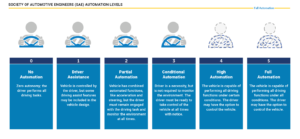No longer limited to pop culture and science fiction, autonomous vehicles are real and are here to stay. Although autonomous vehicles have been in development since the 1920s, only recently has there been a big push from entities such as the National Highway Traffic Safety Administration (“NHTSA”) and the Department of Transportation (“DOT”) for these types of vehicles. One explanation for this recent push is that autonomous vehicles (“AV”) are expected to reduce MVAs by 80% to 90%, since the “NHTSA” estimates 94% of motor vehicle accidents are caused by human error. But what exactly does “autonomous vehicle” mean?
The NHTSA recognizes 5 levels of automation in the context of motor vehicles:

The first three levels (0-2) are the vehicles with which most current drivers are acquainted-for example:
Ø A 1994 Jeep Wrangler with a manual transmission (and no cruise control) is generally considered a Level 0 or No Automation.
Ø A 2010 Nissan Maxima with cruise control would be a Level 1 or driver assistance vehicle.
Ø A 2014 Honda Accord with a lane keeping assisted system and adaptive cruise control is a Level 2 or partial automation; such vehicles are the most common on the road these days.
The differences between Level 1 vehicles and Level 2 vehicles are not well defined; however, generally, Level 2 vehicles consist of more automated features such as accelerating and deaccelerating, steering assistance, and braking. For these lower level automated vehicles, a driver must pay attention and monitor the environment at all times.
Level 3 vehicles, which are also called conditional automation vehicles, are on the market and are becoming widely available. The driver must still be ready to take control of the vehicle at all times with level 3, since the technology is still being developed. For example, a 2018 Tesla’s autopilot is a level 3 or conditional automation, and the driver is necessary to the safe operation of the vehicle and must be ready to take control of the vehicle at all times.
In contrast, for Level 4 and Level 5 vehicles, a driver would NOT be required to monitor the environment when using the autonomous features. Although there are NO Level 4 or Level 5 vehicles on the market at this time; Hollywood has given us several examples:
Ø The Audi RSQ sport coupe from I, Robot (2004) appears to be a level 4 or high automation-since Will Smith is able to take control of the vehicle.
Ø The Lexus 2054 from Minority Report (2002) appear to be level 5 or full automation i.e. driverless.
Auto manufacturers, software companies, and a variety of startups are coming together to create and implement different prototypes of Level 4 and Level 5 vehicles, including Google/Waymo, Apple, Uber, Tesla, GM, Ford, Toyota, Nissan, Volvo, BMW, Mercedes, and Audi. Some of the prototypes for level 5 full autonomous vehicles do not even have steering wheels, accelerators, or brakes, meaning the human occupant will not be able to operate the vehicle.
It is likely that fully automated vehicles will be on the market sooner than you think; however, auto manufacturers are still seeing issues with human error and Level 3 vehicles. For this reason, some manufacturers – Ford, for example – are hoping to bypass Level 3 vehicles in favor of developing Level 4 autonomous vehicles. Such manufacturers suggest it is unfair to ask a driver to “instantaneously intervene” when an issue presents itself when in the high automated state found in Level 3 vehicles.
Automation-whether full or partial-presents risk. DOT and NHTSA, which is responsible for regulating the safety, design, and performance of autonomous vehicles, are implementing guidelines to allow for the full testing of autonomous vehicles in the market place without states’ legislatures interfering. However, States will still be responsible for regulating the human driver in most aspects of vehicle operation, including driver licensing, vehicle registration, and titling, and ensuring the traffic laws do not hamper AV technology.
This division of labor leaves us with an interesting question-in the context of motor vehicle accidents, who will be responsible if something goes wrong?
Check back for our next installment discussing this very issue.
‘Phantom Auto’ Will Tour City, The Milwaukee Sentinel, December 8, 1926. https://news.google.com/newspapers?id=unBQAAAAIBAJ&sjid=QQ8EAAAAIBAJ&pg=7304,3766749
https://www.nhtsa.gov/technology-innovation/automated-vehicles-safety
https://www.nhtsa.gov/technology-innovation/automated-vehicles-safety
Arthur D. Spratlin, Jr., The Autonomous Vehicle Revolution: Expands to Trucks, For the Defense, Dec. 2017 at 77.
https://www.techrepublic.com/article/autonomous-driving-levels-0-to-5-understanding-the-differences/
Arthur D. Spratlin, Jr., The Autonomous Vehicle Revolution: Expands to Trucks, For the Defense, Dec. 2017 at 77.

